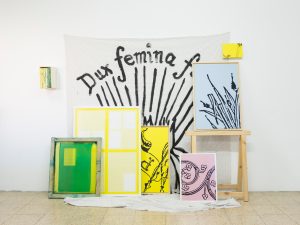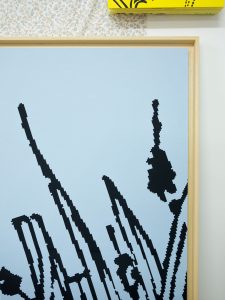You have to write it again, and again, and again. Davinia V. Reina
The work of Davinia V. Reina (Seville, 1986) is developed through the languages of graphic design, printing, installation and book publishing. On this occasion we can see a series of works that she has developed over the last two years, Victoria Regia, which brings us closer to the work as printers of a group of women who, in Victorian England, organized and self-employed to create books and publications that disseminated proto-feminist texts and ideas and in defense of equality.
You have to write it again
and again, and again, and again
(Text: Raquel G. Ibáñez)
Take one or several books. Immerse yourself in them until there is no breath left. Atomize the content, the letters and the glyphs, the absences left by a blank page. To decompose them, after all, is pure cellulose, inks, some glue and thread. Recreating oneself in the material potentiality. This project contains books that in turn spits out, as a sort of poetic autophagy.
The silkscreen printing plates are arranged raw, with their ink stains overflowing the frames, in a game without flourish or trompe l’oeil. Rectangular shapes that are stacked and placed, creating a parade of layers where, ironically, it is possible to see an evident concealment of information. A formal code that calls for the approach of the bodies; the entry into the elements that make up the installations in order to tension what is -and imagine what could be- an exercise of non-linear reading. In “You have to write it again, and again, and again”, the questioning of the story is in all the pieces that compose it.
Fragmenting the narrative is possibly the smallest gesture to create fissures in the status quo that it represents and validates: to perforate a hole to slip through, -to gently dare it- is to open the crack to illuminate the invisible and give agency to subalternities. Cheryl Buckley (1), pointed out the direct responsibility of design historians for the creation of a deeply patriarchal narrative since they have systematically ignored the women who have been part of the development of the craft. What was a very crude process of erasure – a total vacuum – was refined by more sophisticated and perverse strategies: classifying, hierarchizing and prioritizing certain types of design, categories, styles, movements and modes of production that have been beyond women’s control and have thus served to exclude them from history (2).
“You have to write it again, and again, and again” is a double exercise in tearing apart these hegemonic narratives. The project begins with the revision of materials based on editorial design practices that sought to tension this historiography, through the reorganization of the work and the production of feminist thoughts in a very specific context, such as the English Victorian era. Davinia V. Reina articulates her process through the recovery of publications edited by Victoria Press, a printing house created by Emily Faithfull in 1860 whose workers were women in a completely masculinized sector. The artist works mainly with two initiatives born in this printing house: The English Women’s Journal and Victoria Regia. The first, a bourgeois magazine of proto-feminist character where women could disseminate, among other things, the suffragette ideology; the second, a collection of prose and poetry edited by the feminist poet Adelaide Anne Procter.
Just 60 years later, Virginia Woolf published A Room of One’s Own. In one part of the book, the fragmentation of the writing leads directly to an enumeration that might as well be a poem:
Revered as goddesses by,
Morally weaker than,
Idealism of,
More conscience of,
Offered as a sacrifice to
Weaker musculature of,
Intensity of the affections of,
Vanity of, (3).
The list is made up of 23 lines, although only 8 are shown here, in a whimsical and intentional disorder. Woolf’s text addresses a series of issues that have to do, precisely, with the story of women constructed through male voices and how history and literature create images of women that do not correspond to domestic reality. She also points out the figure of the historian and the expert as legitimizing agents and, therefore, oppressors. It states the impossibilities of women’s professional development, although, in this case, linked to literary production. But, as we said at the beginning, books are always present in this project. As with the enumeration of the British writer, Davinia makes an editing and rewriting exercise on the materials of Victoria Press: she selects pieces that she then arranges as handmade publications. In a gesture of addition and subtraction, the artist immerses herself in very specific contents to work from their own decomposition; thus enhancing the fragmentation of the discourse as a way of soft, malleable polyphony; a way of bringing those voices to a different context: bringing them to the present without testimonial pretensions, but as questions that question us in the here and now.
Under this same logic of addition and subtraction, the notion of “layer”, understood as a stratum, is introduced into the project, interconnecting the rhetorical with the literal. Layers appear in many graphic arts processes: spaces that receive the ink, hollows that are reserved for the paper, colors that are added, thus feeding the overall composition of the image. Screen printing or any work with graphic editing software uses this system. They are superimposed, offering an additive richness, but can also play with their opacity, hiding the origins. In silkscreen printing, the medium used by Davinia, other variables operate that enrich the proposal, since it is a technique that works in negative, in such a way that what has been selected to be rewritten belongs to the fields of darkness. A liminal space between what is visible and what is kept hidden, which questions us about the legibility of the silenced voices.
The creation of Victoria Press acted directly on the employability of women, rejecting the sexual differentiation of work. The most traditional conception of design is closely linked to the craft: a space where creativity is at the service of a technique that is also functional. There is a manual romanticism around editorial design: in some way it safeguards and preserves a knowledge that is disseminated thanks to the arts of the book. Although an incunabulum and a manuscript are very obvious examples, printing presses continue this tradition in a sort of hierarchical liturgy, rather than a production chain. The physicality of printing presses (heavy and robust machinery, strong solvents, as well as metallic sounds) entails an imaginary that mixes the manual, the industrial and something that belongs to another sphere of the poetic or intellectual. In this historiographic exercise of design classification, women were left out, in part, because they had been relegated to minor design categories due to their relationship of use. Women were closer, then, to crafts and decorative arts, producing objects for domestic contexts; objects that -in addition- had a determined temporality that compromised their transcendence in history: a pot breaks, a dress wears out.
In “You have to write it again, and again, and again” we find the tools but also the results. Frames and silkscreen printing plates, hand-bound books; glass and ceramics with a clear nod to the ornamental. The domestic and the industrial; the geometric and the organic forms, contaminate and envelop each other, delicately. Here there is a clear will to move away from the modernist watertight categories and the perverse conception of “good design”, reaffirming the work with the body, manual processes where no virtuosity or a flawless invoice is sought, nor the creation of exclusive or genuine objects; there is no stated functionality. Books that are not books; ceramics exempt from a hand that uses them or walks through them. And the fact is that this whole process is, once again, an exercise in writing that crosses formats. It is written with ink, with clay and body; without erasing the trace of the pulse, of the hand, its temperature and breath. And the fact is that, as Ursula K. Leguin would say:
Their work is
is done with pots and baskets,
wallets, tins, boxes, travel bags, pans, pots, jars, cupboards, closets, closets, rooms in houses, doors, desks in the rooms of houses, drawers and boxes in desks, secret compartments in which secret writings
in which secret writings endure for generations.
Their work
is done with letters,
secret letters.
Letters that were not written
for generations.
You have to write it
again and again, and again.
Work with the body,
a laborer. (4).
———————————————————————
Cheryl Buckley. Made in Patriarchy: Toward a Feminist Analysis of Women and Design.
Raquel Pelta. Women and typography: a place in history.
Virginia Woolf. A Room of One’s Own.
Ursula K. Leguin. The Writer on Her Work.
Photographs: María Platero



